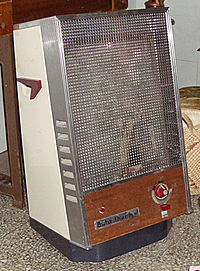Gas heater
This article is written like a personal reflection, personal essay, or argumentative essay that states a Wikipedia editor's personal feelings or presents an original argument about a topic. (November 2010) |

A gas heater is a device used to heat a room or outdoor area by burning natural gas or liquefied petroleum gas. Indoor household gas heaters can be broadly categorized in one of two ways: flued or non-flued, or vented and unvented. Gas heaters can be dangerous due both to risk of fire, and to the emissions, particularly in non-flued heaters.
History
The first gas heater made use of the same principles of the Bunsen burner invented in the previous year. It was first commercialized by the English company Pettit and Smith in 1856. The flame heats the air locally. This heated air then spreads by convection, thus heating the whole room. Today the same principle applies with outdoor patio heaters or "mushroom heaters" which act as giant Bunsen burners.
Beginning in 1881 the burner's flame was used to heat a structure made of asbestos, a design patented by Sigismund Leoni, a British engineer. Later, fire clay replaced the asbestos because it is easier to mould. Modern gas heaters still work this way although using other refractory material.
Modern gas heaters have been further developed to include units which utilize radiant heat technology, rather than the principles of the Bunsen burner. This form of technology does not spread via convection, but rather, is absorbed by people and objects in its path. This form of heating is particularly useful for outdoor heating, where it is uneconomical to attempt to heat a large volume of air.
Flued heaters
Flued heaters would always be permanently installed. The flue, if properly installed with correct overall height, should extract most heater emissions. A correctly operating flued gas heater is usually safe.
Non-flued heaters
Non-flued heaters – also known as unvented heaters, ventfree heaters or flueless fires may be either permanently installed or portable, and generally incorporate a catalytic converter.[1] Non-flued heaters can be risky if appropriate safety procedures are not followed. There must be adequate ventilation – which is a problem due to the ventilation cooling the house, counteracting the heating – they must be kept clean, and they should always be switched off before sleeping. If operating correctly the main emissions of a non-flued gas heater are water vapour and carbon dioxide. If there is incomplete combustion, toxic products such as carbon monoxide and nitrogen dioxide form. If ventilation is poor, the carbon dioxide level in a room will begin to increase, and prevent the release of carbon dioxide from the blood to the room air (see lung) way before the decrease of available oxygen (or carbon monoxide forming) becomes a problem.
See also
References
This article needs additional citations for verification. (April 2011) |
